Hands up if you remember the original Sam and Max? You know, the one from Lucas Arts? That was released 14 years ago, back in 1993? We're sure many of you will, and those of you that haven't played it will surely be aware of the legendary status it enjoys in the hallowed halls of PC gaming.
Sam and Max Hit the Road is generally seen as the seminal adventure game, the king of all point-and-clickers. It came out of Lucas Arts at the time when the firm was unmatched at creating 2D adventurers - Monkey Island, Day of the Tentacle and Full Throttle were the game's peers, and these were also revered as amongst the best the genre had to offer.
But alas, FPS games, strategy and consoles ended up killing the adventure genre, and most pundits regard Grim Fandango as the last hoorah for Lucas Arts in the adventure world. In a world of PlayStation and Grand Theft Auto, who wants to click through 2D worlds for bizarre clues?
Well, the creator of Sam and Max - a chap called Steve Purcell - has taken the pair to Telltale Games, and a new Sam and Max adventure is on us, single-handedly reviving the adventure genre. Are adventure games worth playing in the 21st century, and is this incarnation of the detective duo worth forking out the cash for, or is it a sad rehash of the original? That's what we're here to find out.
Episode three hits the virtual shelves imminently, and we figured that now was a pretty good time to start evaluating the series. Reviewing one episode as a series launches is always a little dangerous - we checked out SiN Episodes a while back, and consequently the series had development halted, making the first part a little pointless. Telltale Games is going the whole hog, though, and with three episodes in the bag, the likelihood of them cutting and running with your season pass money appears minimal.
Each month there is a new episode scheduled, and we are checking out the first one today, Culture Shock, originally released back in October, but only available for purchase outside of the US since November. Is it as manic as we could hope?
Avid fans of the original will instantly feel at home here, whilst new players will find the 3D world familiar enough to be encouraged to plough on in. The voice acting is also immediately revealed as A-grade, amongst the best in any video game to date - whilst they are not the same actors as in the original, this does not detract from the experience.
That Steve Purcell has had a hand in the game is evident - the dialogue is snappy and humorous, and there are big laughs to be had in just the opening scene which, bizarrely, involves a rat, a telephone, some cheese and the mob. Yes, Sam and Max is just as surreal as you'd have hoped.
You are also presented with the opportunity to get to grips with the interface, which is a piece of cake. It's context-sensitive single click, differing from the previous version, which asked you to Look, Use or Talk. Here, clicking an object will pick it up, and dragging it from your inventory to the locale will use it in the desired location. Clicking a person will start a conversation, and your inventory is accessed by clicking the cardboard box in the bottom left of the screen. Even the options interface is minimal interaction - a few resolution choices and that's about it.
Sam and Max Hit the Road is generally seen as the seminal adventure game, the king of all point-and-clickers. It came out of Lucas Arts at the time when the firm was unmatched at creating 2D adventurers - Monkey Island, Day of the Tentacle and Full Throttle were the game's peers, and these were also revered as amongst the best the genre had to offer.
But alas, FPS games, strategy and consoles ended up killing the adventure genre, and most pundits regard Grim Fandango as the last hoorah for Lucas Arts in the adventure world. In a world of PlayStation and Grand Theft Auto, who wants to click through 2D worlds for bizarre clues?
Well, the creator of Sam and Max - a chap called Steve Purcell - has taken the pair to Telltale Games, and a new Sam and Max adventure is on us, single-handedly reviving the adventure genre. Are adventure games worth playing in the 21st century, and is this incarnation of the detective duo worth forking out the cash for, or is it a sad rehash of the original? That's what we're here to find out.
Season pass
The immediately odd thing about the game is its purchase method. Yes, the new Sam and Max is an Episodic game, and Culture Shock is merely episode one. You can choose to purchase just the first episode for about $8, or a 'season pass' to all six for $34. Even better, if you buy just the one and end up liking it, you can upgrade to a season pass for $26, which seems entirely fair and reasonable. Each episode is between 3-4 hours of gameplay, making for a 20-hour game in total - pretty good value.Episode three hits the virtual shelves imminently, and we figured that now was a pretty good time to start evaluating the series. Reviewing one episode as a series launches is always a little dangerous - we checked out SiN Episodes a while back, and consequently the series had development halted, making the first part a little pointless. Telltale Games is going the whole hog, though, and with three episodes in the bag, the likelihood of them cutting and running with your season pass money appears minimal.
Each month there is a new episode scheduled, and we are checking out the first one today, Culture Shock, originally released back in October, but only available for purchase outside of the US since November. Is it as manic as we could hope?
Freelance Police
The game starts with the pair in their office - an exact replica of the original game, including the dartboard, open window and dodgy TV. Immediately you are struck by the graphics - rather than the old 2D graphics, this is a new cartoonish 3D rendering. The Telltale team has pulled off a stunning coup in translating the look and feel of the game to something a little more modern and this is no mean feat.Avid fans of the original will instantly feel at home here, whilst new players will find the 3D world familiar enough to be encouraged to plough on in. The voice acting is also immediately revealed as A-grade, amongst the best in any video game to date - whilst they are not the same actors as in the original, this does not detract from the experience.
That Steve Purcell has had a hand in the game is evident - the dialogue is snappy and humorous, and there are big laughs to be had in just the opening scene which, bizarrely, involves a rat, a telephone, some cheese and the mob. Yes, Sam and Max is just as surreal as you'd have hoped.
You are also presented with the opportunity to get to grips with the interface, which is a piece of cake. It's context-sensitive single click, differing from the previous version, which asked you to Look, Use or Talk. Here, clicking an object will pick it up, and dragging it from your inventory to the locale will use it in the desired location. Clicking a person will start a conversation, and your inventory is accessed by clicking the cardboard box in the bottom left of the screen. Even the options interface is minimal interaction - a few resolution choices and that's about it.

MSI MPG Velox 100R Chassis Review
October 14 2021 | 15:04


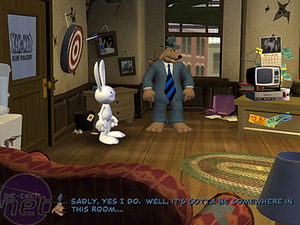
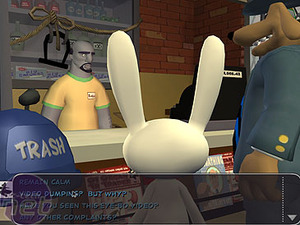

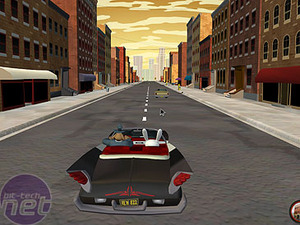
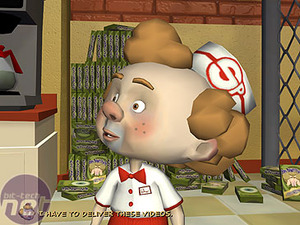
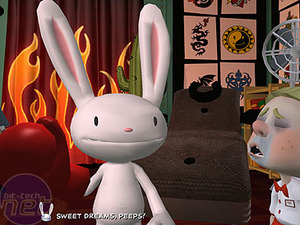








Want to comment? Please log in.